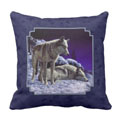Title: Night Watch
Two wolves on night watch duty, guarding their territory for the rest of the wolf pack sleeping blissfully in a nearby den. One wolf keeps a sharp eye on things while the other wolf dozes briefly. Soon they'll switch places, taking turns keeping watch throughout the night. A full moon casts bright light on the wolves and snow. (Copyright and website text will NOT appear on prints and products)
Most people think of wolves in North America as the gray wolf, also known as the timber wolf. But there are actually several subspecies, or types, of wolves living in North America. They are the Arctic wolf (Canis lupus arctos), northwestern wolf (Canis lupus occidentalis), Great Plains wolf (Canis lupus nubilus), Mexican wolf (Canis lupus baileyi), and the eastern timber wolf (Canis lupus lycaon). For most people there is little visual difference between these subspecies. The most noticeable difference is with the Arctic wolf which is often nearly white, especially in its winter coat, although any of the wolf subspecie can range in color from nearly black to white. The Mexican wolf is less likely to have this wide color range and is usually brown and gray. Wolves mate for life and both parents will help raise their young. When grown, a wolf may go off to form its own pack, or stay with the pack. A new wolf pup's pack may consist of an extended family of aunts, uncles, older siblings, and grandparents.
Subject:
Gray WolvesMedium:
Oil PaintingSize:
20"x24"Original:
SOLDPrints of this image:
Paper, canvas, metal, and acrylic Fine Art printsOther Products:
Home decor, Clothing & Apparel, accessories, and more







